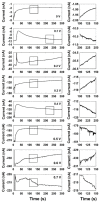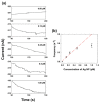Electrochemical Detection and Analysis of Various Current Responses of a Single Ag Nanoparticle Collision in an Alkaline Electrolyte Solution
- PMID: 35806475
- PMCID: PMC9267213
- DOI: 10.3390/ijms23137472
Electrochemical Detection and Analysis of Various Current Responses of a Single Ag Nanoparticle Collision in an Alkaline Electrolyte Solution
Abstract
A single silver (Ag) nanoparticle (NP) collision was observed and analyzed in an alkaline solution using the electrocatalytic amplification (EA) method. Previously, the observation of a single Ag NP collision was only possible through limited methods based on a self-oxidation of Ag NPs or a blocking strategy. However, it is difficult to characterize the electrocatalytic activity of Ag NPs at a single NP level using a method based on the self-oxidation of Ag NPs. When using a blocking strategy, size analysis is difficult owing to the edge effect in the current signal. The fast oxidative dissolution of Ag NPs has been a problem for observing the staircase response of a single Ag NP collision signal using the EA method. In alkaline electrolyte conditions, Ag oxides are stable, and the oxidative dissolution of Ag NPs is sluggish. Therefore, in this study, the enhanced magnitude and frequency of the current response for single Ag NP collisions were obtained using the EA method in an alkaline electrolyte solution. The peak height and frequency of single Ag NP collisions were analyzed and compared with the theoretical estimation.
Keywords: alkaline solution; electrocatalytic amplification; electrochemistry; silver (Ag); single nanoparticle; single-molecule studies.
Conflict of interest statement
The authors declare no conflict of interest.
Figures





Similar articles
-
Various Current Responses of Single Silver Nanoparticle Collisions on a Gold Ultramicroelectrode Depending on the Collision Conditions.Chem Asian J. 2017 Sep 19;12(18):2434-2440. doi: 10.1002/asia.201700770. Epub 2017 Aug 16. Chem Asian J. 2017. PMID: 28662286
-
Collision, Adhesion, and Oxidation of Single Ag Nanoparticles on a Polysulfide-Modified Microelectrode.J Am Chem Soc. 2021 Oct 6;143(39):16154-16162. doi: 10.1021/jacs.1c07164. Epub 2021 Sep 22. J Am Chem Soc. 2021. PMID: 34549950
-
Observation of Single Nanoparticle Collisions with Green Synthesized Pt, Au, and Ag Nanoparticles Using Electrocatalytic Signal Amplification Method.Nanomaterials (Basel). 2019 Nov 27;9(12):1695. doi: 10.3390/nano9121695. Nanomaterials (Basel). 2019. PMID: 31783669 Free PMC article.
-
Collision Oxidation Behavior of Silver Nanoparticles in Alkaline Solution.J Phys Chem Lett. 2024 May 30;15(21):5594-5599. doi: 10.1021/acs.jpclett.4c01226. Epub 2024 May 16. J Phys Chem Lett. 2024. PMID: 38755539
-
Adsorption of Silver Nanoparticles onto Different Surface Structures of Chitin/Chitosan and Correlations with Antimicrobial Activities.Int J Mol Sci. 2015 Jun 18;16(6):13973-88. doi: 10.3390/ijms160613973. Int J Mol Sci. 2015. PMID: 26096004 Free PMC article. Review.
References
-
- Van Broekhuizen P., van Broekhuizen F., Cornelissen R., Reijnders L. Use of nanomaterials in the European construction industry and some occupational health aspects thereof. J. Nanoparticle Res. 2011;13:447–462. doi: 10.1007/s11051-010-0195-9. - DOI
-
- Bauer L.A., Birenbaum N.S., Meyer G.J. Biological applications of high aspect ratio nanoparticles. J. Mater. Chem. 2004;14:517–526. doi: 10.1039/b312655b. - DOI
-
- Chen J., Lim B., Lee E.P., Xia Y. Shape-controlled synthesis of platinum nanocrystals for catalytic and electrocatalytic applications. Nano Today. 2009;4:81–95. doi: 10.1016/j.nantod.2008.09.002. - DOI
MeSH terms
Substances
Grants and funding
LinkOut - more resources
Full Text Sources
Miscellaneous

